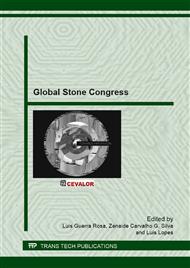[1]
L. Aires-Barros. Alteração e alterabilidade de rochas. Lisboa: Universidade Técnica de Lisboa, Instituto Nacional de Investigação Cientifica (1991) 384p.
Google Scholar
[2]
E.M. Winkler. Stone in architecture: properties, durability. 3 ed. Berlin: Springer-Verlag (1997) 313p.
Google Scholar
[3]
H.A. Viles. Urban air pollution and the deterioration of buildings and monuments. In: D. Brune, D.V. Chapman, M.D. Gruynne, J.M. Pacyna (Ed. ) The global environment: science, technology and management. Weinheim: Scandinavian Science Publ.; VCH (1997).
Google Scholar
[4]
C.M. Grossi, R.M. Esbert and F. Díaz-Pache Degradación y durabilidad de materiales rocosos de edificación en ambientes urbanos. Materiales de Construcción, v. 48, n. 252 (1998) 5-25.
DOI: 10.3989/mc.1998.v48.i252.461
Google Scholar
[5]
A. Begonha, M.A. Sequeira Braga. Weathering of the Oporto granite: geotechnical and physical properties. Catena 49 (2002) 57-76.
DOI: 10.1016/s0341-8162(02)00016-4
Google Scholar
[6]
L.M.O. Sousa, L.M. Suárez del Río, L. Calleja, V.G.R. de Argandoña, A.R. Rey. Influence of microfractures and porosity on the physico-mechanical properties and weathering of ornamental granites. Engineering Geology 77 (2005) 153-168.
DOI: 10.1016/j.enggeo.2004.10.001
Google Scholar
[7]
A. Tugrul, I.H. Zarif. Correlation of mineralogical and textural characteristics with engineering properties of selected granitic rocks from Turkey. Engineering Geology 51 (1999) 303-317.
DOI: 10.1016/s0013-7952(98)00071-4
Google Scholar
[8]
M.H.B.O. Frascá. Porosity and technological properties of granite dimension stone and polished tiles. In: Proceedings of International Congress of the International Association of Engineering Geology and the Environment, 9. Durban, South Africa. (2002).
Google Scholar
[9]
M.H.B.O. Frascá, I.S.C. Mello, E.B. Quitete. Ornamental and dimension stone of the State of São Paulo. São Paulo: IPT (2000) CD-ROM. (IPT. Pub. 2651).
Google Scholar
[10]
M.H.B.O. Frascá. Experimental studies on accelerated weathering of granitic dimension stone. Thesis, Institute of Geosciences, University of São Paulo, Brazil (2003) (in Portuguese).
Google Scholar
[11]
M.J. Le Bas, A.L. Streckeisen. The IUGS systematics of igneous rocks. Journal of the Geological Society, London, 148 (1991).
DOI: 10.1144/gsjgs.148.5.0825
Google Scholar
[12]
H.G. Winkler. Petrogenesis of metamorphic rocks. 4. ed. New York: Springer-Verlag. (1976) 334p.
Google Scholar
[13]
M.C. Moraes, E.P. Rodrigues Exemplo de aplicação de coloração seletiva de feldspatos potássicos e cálcicos, como técnica auxiliar no estudo de rochas. Cerâmica, v. 24, n. 97 (1978).
Google Scholar
[14]
ABNT - Associação Brasileira de Normas Técnicas. NBR 12. 766/92: rochas para revestimento; determinação da massa específica aparente, porosidade aparente e absorção d'água aparente. Rio de Janeiro (1992).
DOI: 10.4322/tmm.2014.046
Google Scholar
[15]
BSI - British Standard Institution. BS EN 1936: natural stone test methods; determination of real density and apparent density and of total and open porosity. London. (1999).
DOI: 10.3403/01663707
Google Scholar
[16]
C. Chiodi Filho, A.T. Takahashi, C.R.R. Silva, J.C.G. Ferreira. Project Capão Bonito; final report. São Paulo: CPRM/Pró-Minério. (1983) v. 1. (in Portuguese).
Google Scholar
[17]
S.R.S.S. Vieira, J.M.V. Coutinho, F.R. Alves. Geology and geologic evolution of the Embu-Guaçu - Parelheiros region. SP. Rev. Bras. Geoc. 20 (l-4) (1990) 277-281. (in Portuguese).
DOI: 10.25249/0375-7536.1990277281
Google Scholar
[18]
F.A.C. Roberto Dimension stone of Ceará: geology, prospection, mining, processing and market. 225p. Dissertation – Department of Geology, University Federal of Ceará, Fortaleza (1998). (in Portuguese).
Google Scholar
[19]
F.W.H. Vidal. Study of the abrasive elements of diamond wire for granite mining of Ceará. Thesis - Polytechnic School, University of São Paulo, São Paulo (1999). (in Portuguese).
Google Scholar
[20]
F.F.M. Almeida, N. Letwinski. Província Mantiqueira; Setor Setentrional. In: F.F.M. Almeida, Y. Hasui (Coord. ) Pré-cambriano no Brasil. São Paulo: Edgard Blücher (1984) 282-307.
Google Scholar
[21]
B.W. Chappell, A.J.R. White. Two contrasting granite types: 25 years later. Australian Journal of Earth Sciences (2001) 48, 489-499.
DOI: 10.1046/j.1440-0952.2001.00882.x
Google Scholar


